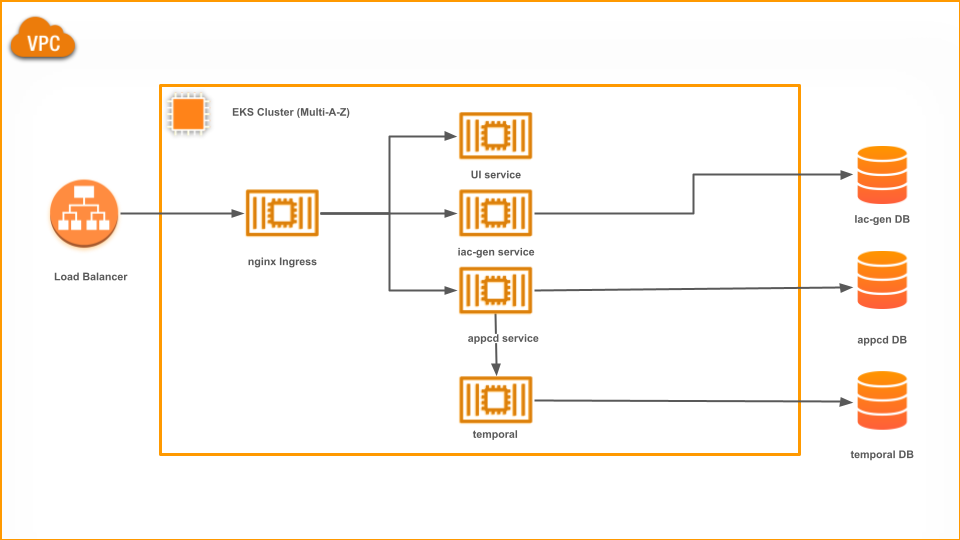Deploy StackGen in Your AWS Cloud
- Introduction
- Technical Prerequisites and Requirements
- StackGen Deployment Architecture on AWS
- Security and Compliance
- Cost and Billing
- Deployment and Maintenance
- Backup and Recovery
- Software Maintenance
- Troubleshooting
Introduction
Click to preview
Why StackGen?
StackGen is designed to streamline application deployment and infrastructure provisioning by generating Infrastructure as Code (IaC) tailored to your application's requirements. Typical use cases include:
- Automating Infrastructure as Code creation for Python and Java apps.
- Managing infrastructure for scalable web applications.
- Ensuring compliance and security in cloud deployments.
Overview of Customer Deployment in AWS
StackGen provides a comprehensive solution for hosting StackGen within your AWS cloud environment. The deployment involves:
- Setting up an EKS cluster.
- Configuring IAM resources.
- Integrating with your existing VPC.
Once deployment is complete, the following resources will be set up:
- Kubernetes cluster on EKS
- IAM roles and policies for access management
- VPC configurations including subnets and security groups
- Helm charts for deploying StackGen services
Expected Deployment Time
The typical deployment, including setting up the required AWS resources and configuring the software, is expected to take approximately 1-2 hours, depending on your network and resource availability.
Supported AWS Regions
StackGen supports deployment in all major AWS regions, ensuring broad availability and compliance with regional regulations. Specific regions can be configured based on your requirements.
Technical Prerequisites and Requirements
Click to preview
Prerequisite Skills
The deployment process requires basic familiarity with the following concepts, tools, or skills:
- AWS services (EKS, IAM, VPC).
- Terraform.
- Kubernetes management.
- Basic understanding of Helm charts.
Environment Configuration
The deployment environment must include:
- An AWS account with administrative access.
- A domain configured in Amazon Route 53.
- A valid SSL certificate in AWS Certificate Manager.
- A TLS certificate in AWS Certificate Manager.
Required Tools
To deploy StackGen, you need:
StackGen Deployment Architecture on AWS

The architecture consists of StackGen, which is hosted on an EKS cluster within an AWS VPC. This setup also integrates StackGen services and databases. The network layer can be customized based on specific requirements.
Security and Compliance
Click to preview
Avoid Using AWS Root Account
- Avoid using the AWS account's root user for deployment or operational tasks.
- Use IAM users or roles with the least privilege necessary to ensure security.
Least Privilege Principle
Apply the principle of least privilege to all IAM roles and policies, ensuring only necessary permissions are granted.
Public Resources
- No public resources are required during the deployment of StackGen.
- Resources are configured for private access within the VPC by default.
IAM Roles and Policies
Example IAM Policy for EKS
{
"Version": "2012-10-17",
"Statement": [
{
"Effect": "Allow",
"Action": [
"eks:CreateCluster",
"eks:DescribeCluster",
"eks:ListClusters",
"eks:DeleteCluster"
],
"Resource": "*"
}
]
}
Example IAM Policy for VPC
{
"Version": "2012-10-17",
"Statement": [
{
"Effect": "Allow",
"Action": [
"ec2:CreateVpc",
"ec2:DescribeVpcs",
"ec2:DeleteVpc",
"ec2:CreateSubnet",
"ec2:DescribeSubnets",
"ec2:DeleteSubnet",
"ec2:CreateRouteTable",
"ec2:DescribeRouteTables",
"ec2:DeleteRouteTable"
],
"Resource": "*"
}
]
}
Keys and Secrets Management
- Use AWS Secrets Manager to securely store sensitive data, such as database credentials.
- Regularly rotate secrets to enhance security.
Data Storage and Encryption
- Ensure all data stored in S3 is encrypted using server-side encryption (SSE-S3 or SSE-KMS).
- Enable encryption for EBS volumes to secure data at rest.
Cost and Billing
Click to preview
Billable Services
- Amazon EKS (mandatory).
- Amazon RDS (optional, if using managed databases).
Licensing Costs
StackGen requires licenses to be included in your subscription package. Contact the StackGen Support for specific costs.
Deployment and Maintenance
Click to preview
Step-by-Step Deployment Instructions
-
Prepare the Environment
- Install the required tools -
TerraformandOpenTofu:
sudo apt-get install terraform tofu- Install
kubectl:
curl -LO "https://storage.googleapis.com/kubernetes-release/release/$(curl -s https://storage.googleapis.com/kubernetes-release/release/stable.txt)/bin/linux/amd64/kubectl"
chmod +x ./kubectl
sudo mv ./kubectl /usr/local/bin/kubectl- Install Helm:
curl https://raw.githubusercontent.com/helm/helm/master/scripts/get-helm-3 | bash- Configure AWS CLI:
aws configure - Install the required tools -
-
Configure IAM Roles
Create necessary IAM roles and policies using the examples provided here.
-
Configure DNS and SSL
Set up Route 53 records and SSL certificates in AWS Certificate Manager. Update
variables.tfvarsaccordingly. -
Provision StackGen
Use Terraform to set up StackGen in AWS:
terraform init
terraform apply -var-file="variables.tfvars"
Testing and Troubleshooting
-
Verify that all services are running as expected:
kubectl get pods -n appcd
Health Monitoring
- Use AWS CloudWatch to monitor health metrics (e.g., CPU utilization, memory usage, and network traffic).
Backup and Recovery
Click to preview
Software Maintenance
Click to preview
Patches and Upgrades
- Check for updates and apply patches as needed.
- Follow official documentation for upgrading Helm charts and Terraform scripts.
License Management
- Ensure software licenses are up-to-date.
- Renew licenses as needed.
AWS Service Limits
- Monitor AWS service limits and request increases as required for scaling.
Troubleshooting
Click to preview
Fault Conditions
- Check CloudWatch logs for errors.
- Verify the status of Kubernetes pods.
- Ensure IAM roles and policies are correctly configured.
Technical Support
For support, contact the StackGen team at support@stackgen.com.
Support Tiers and SLAs
StackGen offers enterprise support with a 24-hour Service Level Agreement (SLA). Ensure you are aware of your support tier and corresponding SLA.